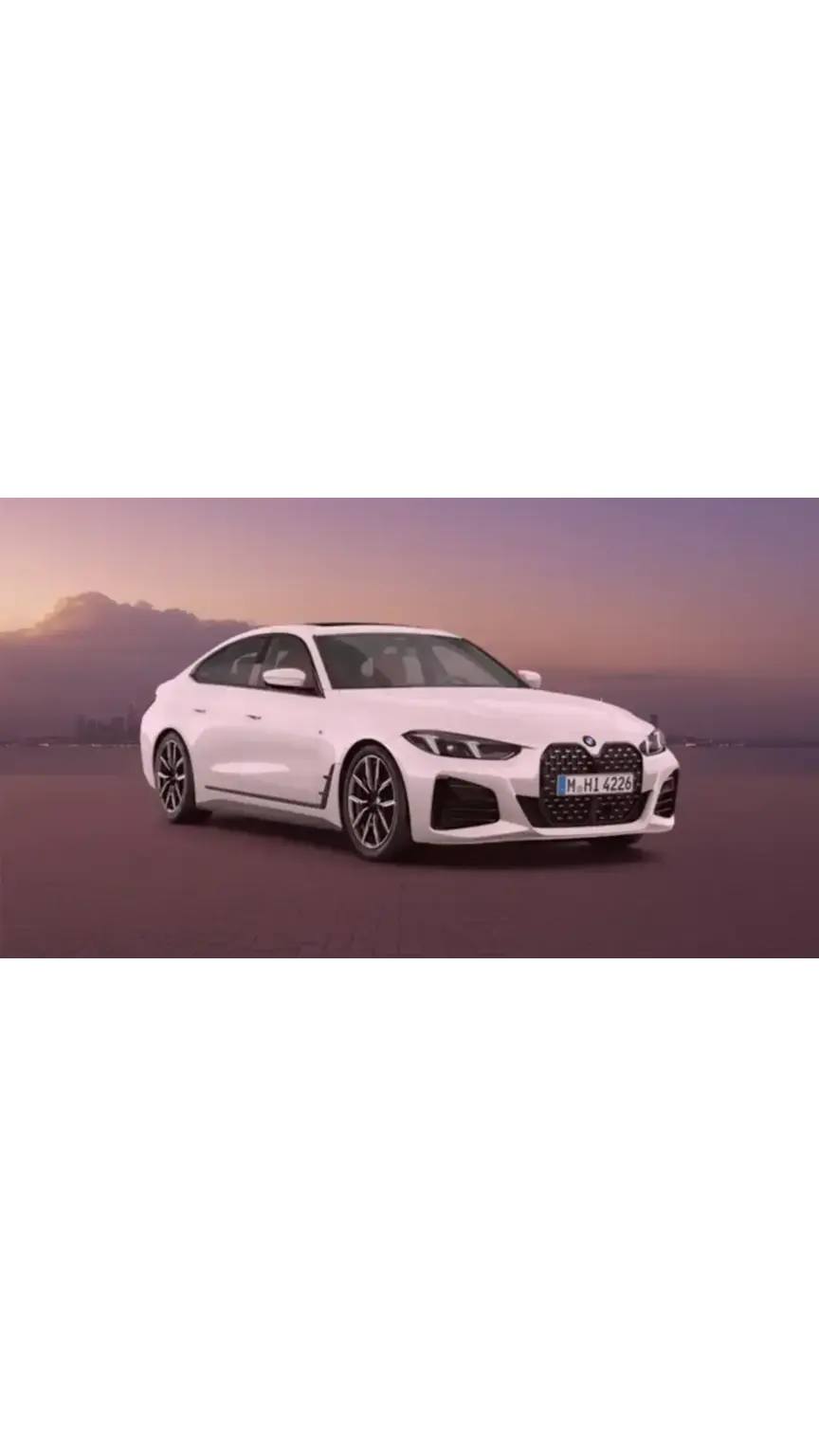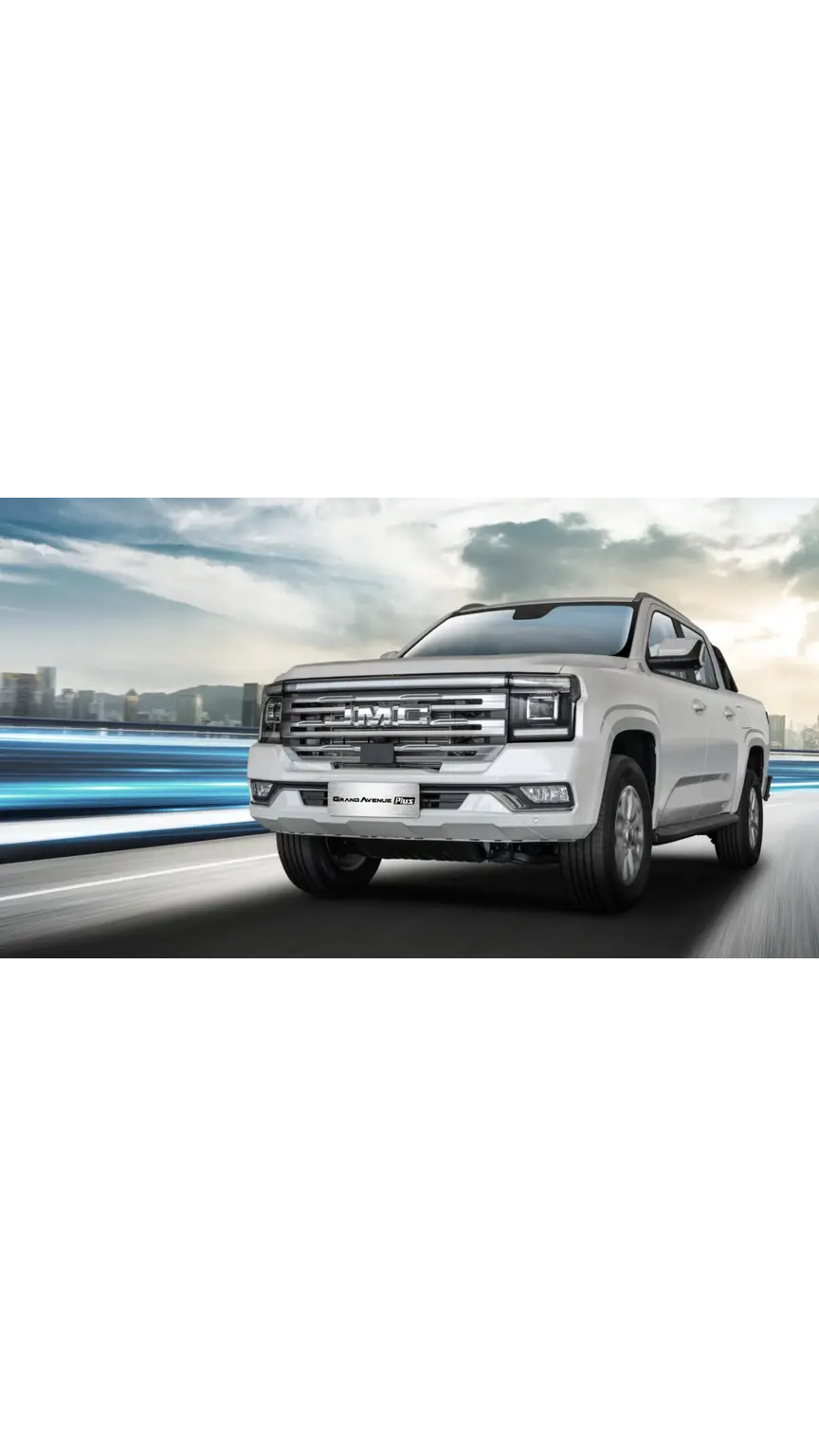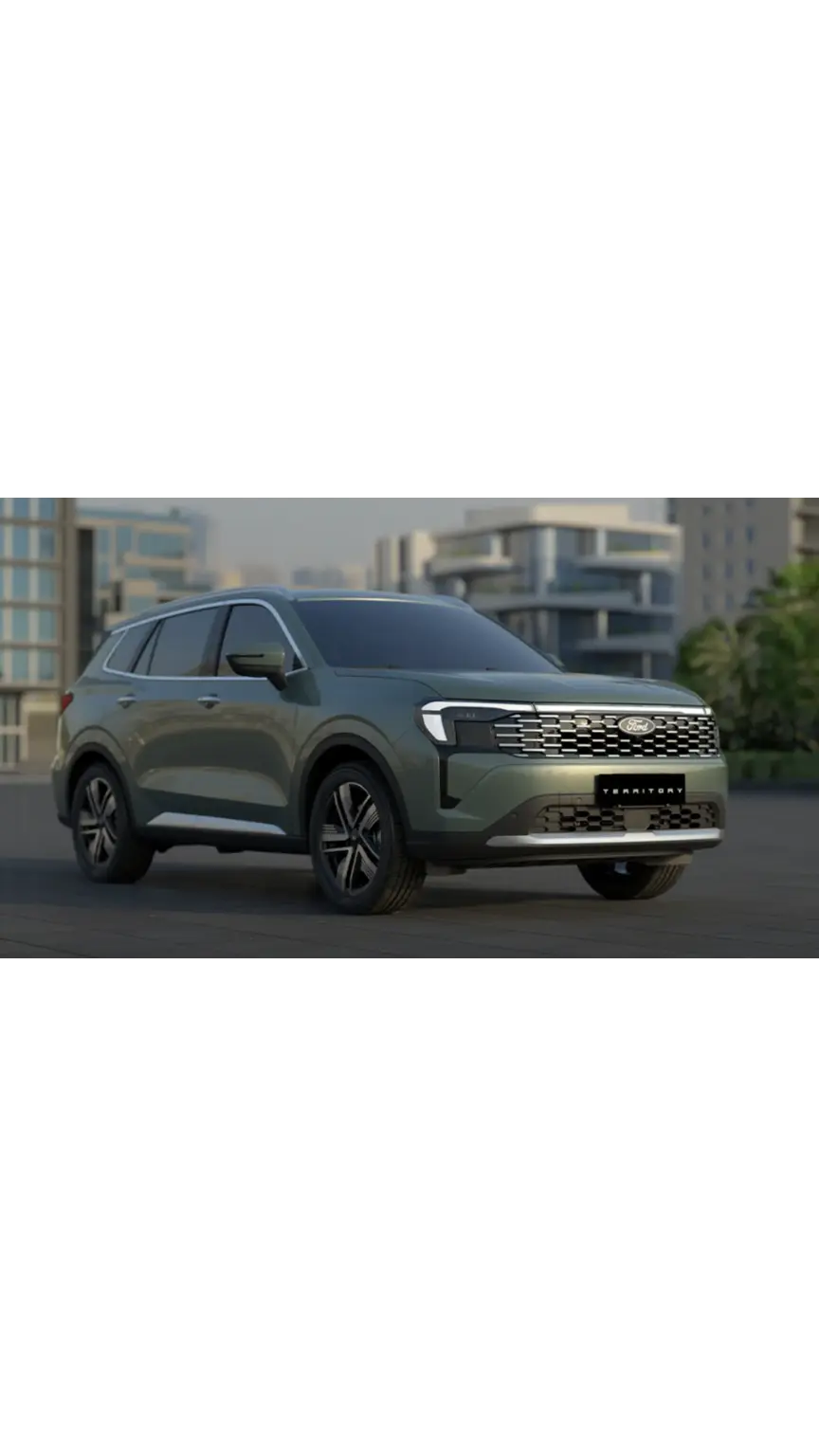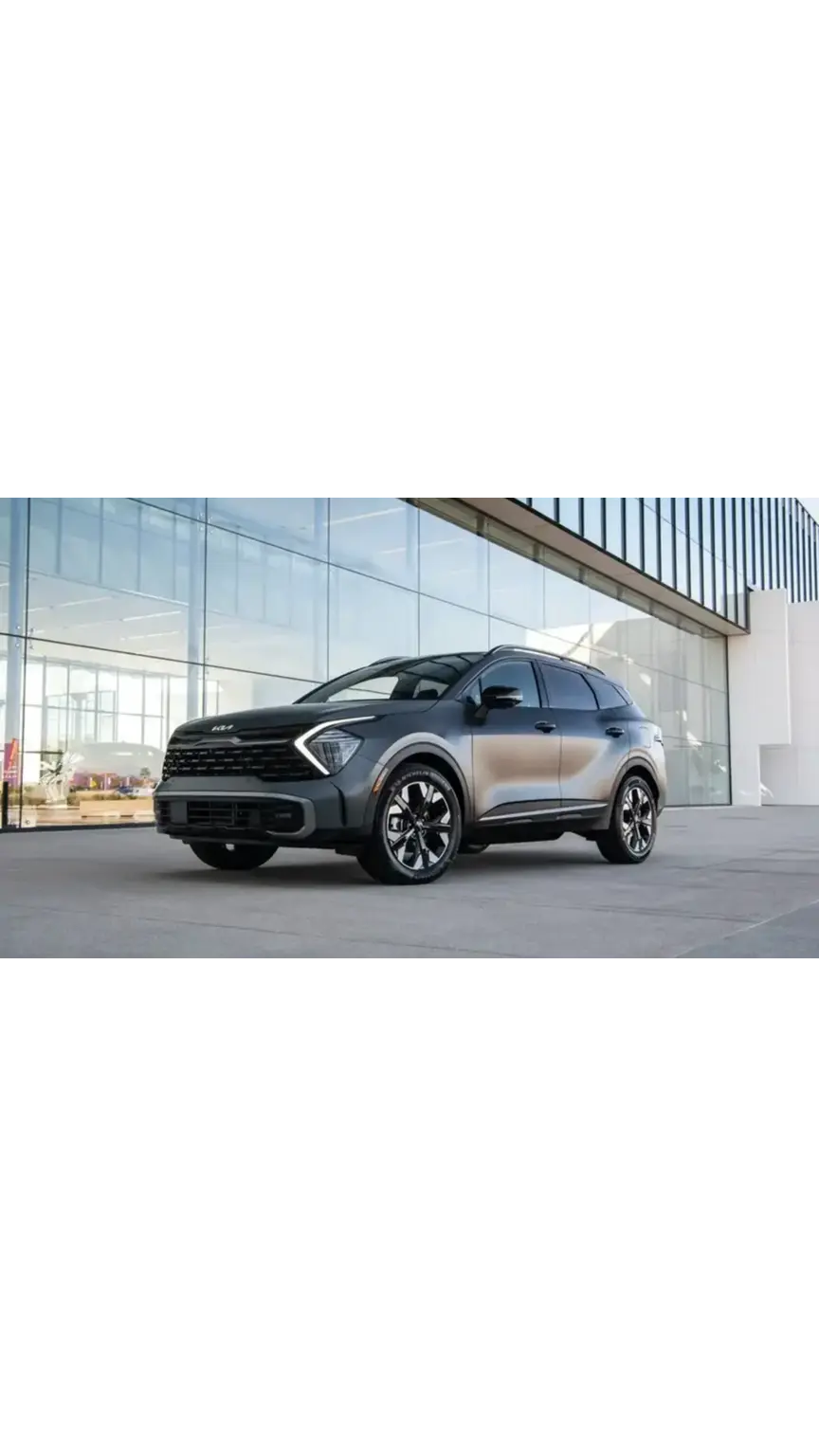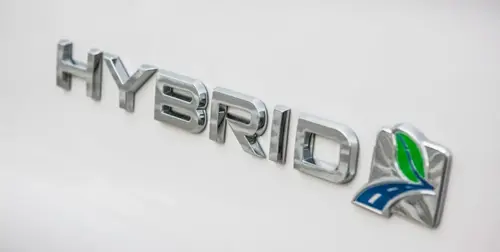The car’s dashboard, also known as the “instrument panel,” serves as a unique unspoken language between the vehicle and its driver. It sends instant signals and messages regarding the car’s mechanical and electrical condition. So, understanding the car dash warning lights’ meanings can help reduce the likelihood of high-cost repairs and protect the driver from dangerous situations on the road.
The design of these symbols might vary from one manufacturer to another and from one model to the next, however, most car warning lights follow globally standardized guidelines, making them very easy to understand.
It’s worth noting that the car warning light symbols show how serious each warning is using colors:
- Red: Indicates a serious problem that requires stopping the car immediately and having it checked by a specialist
- Yellow or Orange: This warning signals that the system needs to be checked soon, but not immediately
- Green: Indicates the system is operating normally
- Blue: Shows that some special indicators, such as high beam or other systems, are active right now
In this article, we will provide a comprehensive reference of all the dashboard warning lights along with the meaning of each one.
Red Warning Lights (High Risk)
Engine Oil Warning Light

This light indicates a problem in the engine’s oil circulation system, such as:
- Low oil level in the tank
- Insufficient oil pressure inside the engine
- Fault in one of the components like the oil pump or sensors
If this light appears on the dashboard, you should stop the car immediately and check the oil level before continuing to drive, because ignoring it will cause serious damage, like engine failure.
Engine Temperature Warning Light
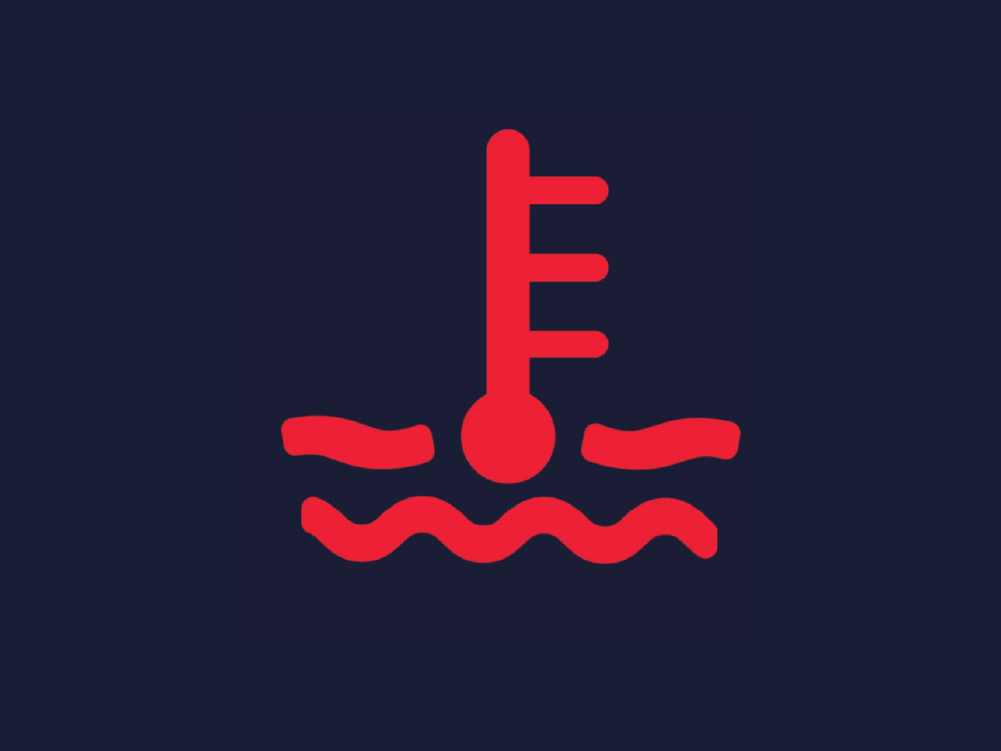
One of the most important warning lights is the engine temperature light, which indicates that the engine is overheating. This could be caused by:
- Low coolant level in the radiator
- Fault in the cooling fan or engine thermostat
- Blockage in the cooling system or a leak in the hoses
- Low engine oil level
If this light appears on the dashboard in red, it’s best to pull over immediately and wait for the engine to cool down before continuing to drive.
Red Battery Warning Light

This light signals an issue with the battery charging system or electrical circuit. Possible causes include:
- Faulty alternator or the belt powering it
- Weak or drained battery
- Worn out battery (needs replacement)
- Faulty or damaged electrical wiring
When this light appears, it means the battery is no longer charging properly. So, continuing to drive without addressing this issue could fully drain the battery, preventing the driver from starting the car or operating any of its electrical systems.
Parking Brake Warning Light
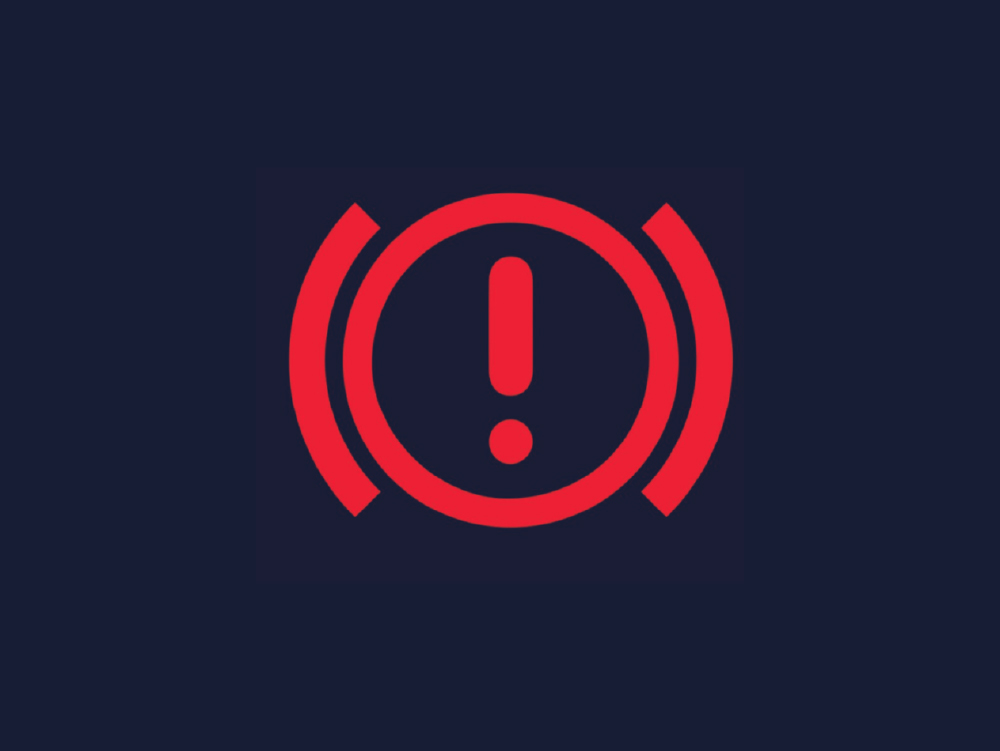
This light indicates a problem in the braking system. Also, it may appear due to one of the following reasons:
- Handbrake lever is partially or fully engaged while driving
- Low brake fluid level
- Fault in one of the braking systems, such as ABS
Other Brake-related Indicators
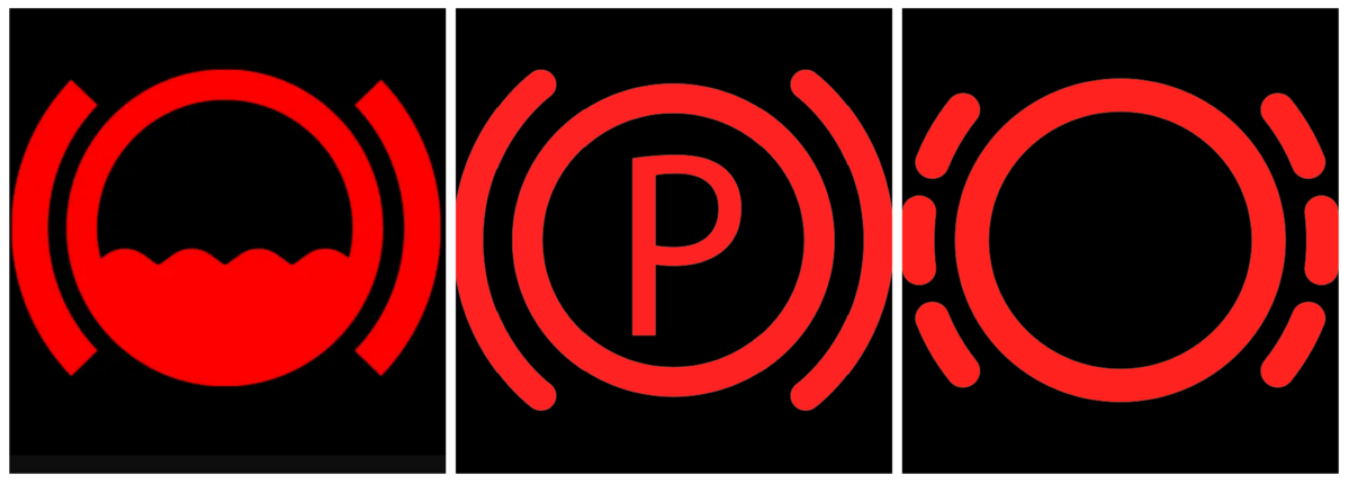
- Dotted line symbol indicates a fault in the brake pads, so they must be replaced
- Letter “P” symbol points to a malfunction in the handbrake system
- Last indicator on the left shows that the brake fluid level is low
This warning light indicates that you should pull over immediately and check the brakes to avoid potential loss of control over the vehicle.
Electric Power Steering Warning Light

One of the important warning lights on the dashboard relates to the Electronic Power Steering (EPS) system. The main causes for this light to appear include:
- Fault in the electric steering motor
- Problem with sensors or electrical wiring
- Malfunction in the system’s control unit
All you have to do is pull over safely, turn off the engine, and restart it after 30 seconds. If the light is still on, you can continue driving for a short distance, but you should head to a service center immediately, and you might notice that steering feels heavier, making maneuvering more difficult.
Seat Belt Warning Light

This symbol illuminates to remind the driver to fasten his/ her seat belt, and it’s usually accompanied by a warning sound. This alert is not limited to the driver; in most cars, it also notifies the front passenger, and in some vehicles, there might be warnings for the rear-seat passengers.
Sometimes, a fault in the seat belt sensor can cause the light to appear even when all seat belts are fastened. In such cases, take the vehicle to a service center to have the issue checked.
Yellow or Orange Vehicle Warning Lights (Lower Risk)
Automatic Transmission Warning Light
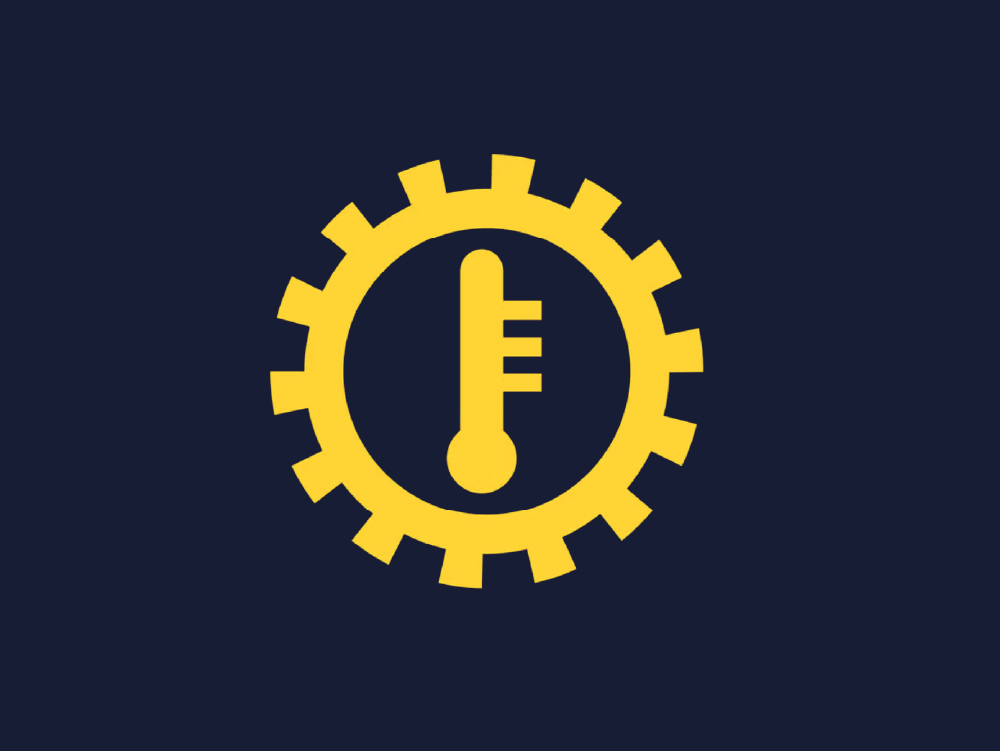
This indicator appears as a coiled circle with an exclamation mark or a thermometer inside. It signals the following:
- Fault in the transmission system
- Transmission fluid overheating
- Low or contaminated transmission oil
- Malfunction in the transmission’s control unit or sensors
It’s recommended to regularly check the transmission fluid level, inspect the cooling fan and radiator cap, and check if there's a coolant leak.
Check-engine Warning Light
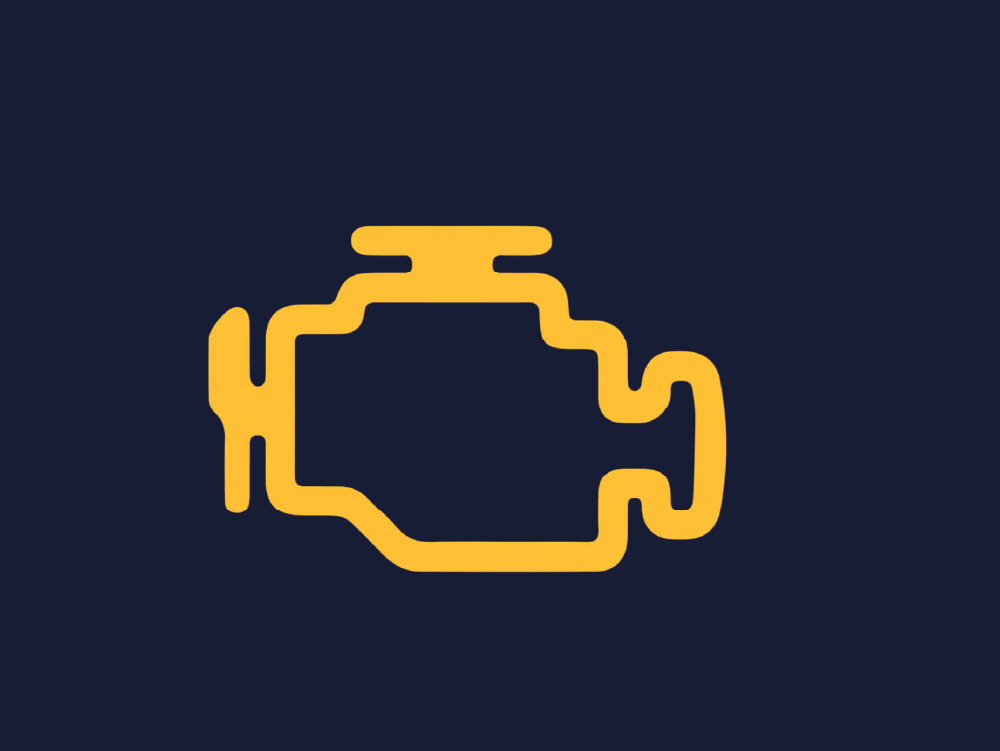
This dashboard light signals an issue with the engine or emissions system. Possible causes include:
- Fault in the oxygen sensor or any other sensor
- Damaged spark plugs or the fuel injectors
- Malfunction in the catalytic converter or emissions system
This light normally appears each time you start the car and then goes off, which is completely normal. However, if it stays on, you should visit a service center to let a technician inspect the car’s engine and determine the cause. Ignoring this warning light can lead to increased fuel consumption and other serious issues.
ABS Warning Light (Anti-lock brakes)
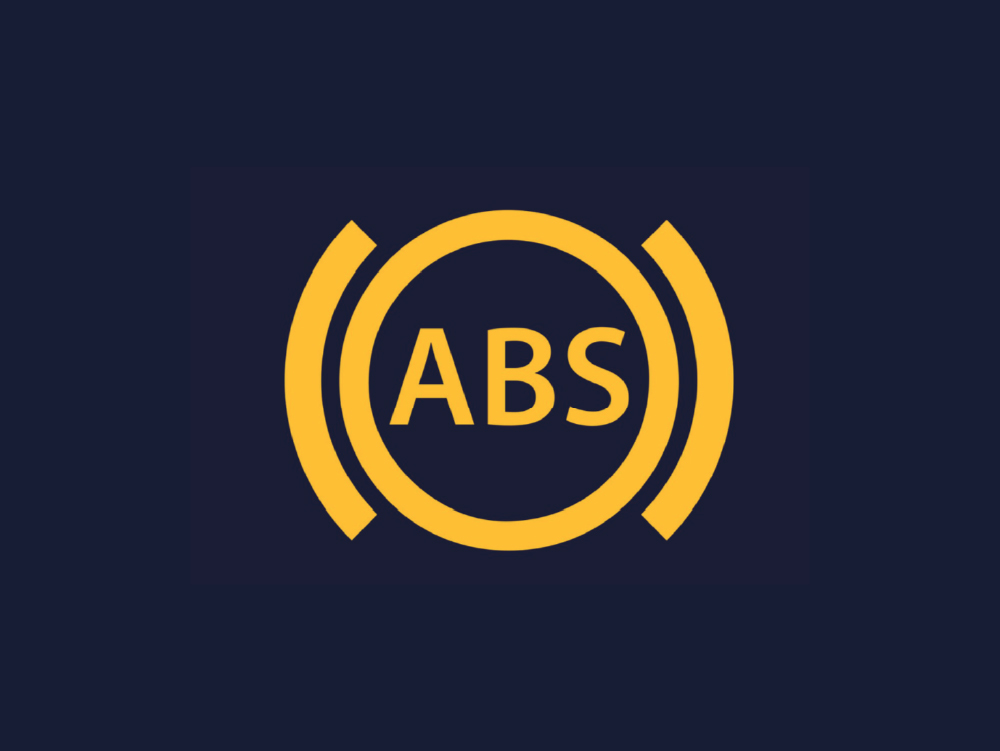
This indicator lights up on the dashboard to warn the driver of a problem with the Anti-lock Braking System (ABS). The issue might be caused by:
- Fault in the wheel speed sensor
- Damaged ABS control unit
- Faulty or disconnected wiring
- Malfunction in the ABS pump or fluid pressure system
Even though this light indicates a fault in the ABS system, it doesn’t necessarily mean that the brakes themselves have failed. However, if the ABS light appears along with the red brake warning light, you must stop the car immediately and seek professional assistance, as this clearly signals a brake failure.
Reduced Engine Power Warning Light

This light indicates that the Engine Control Unit (ECU) has detected a problem affecting the engine’s performance or transmission’s efficiency. So, in order to protect the internal components, the system automatically reduces engine power, which means that the ECU limits the vehicle’s ability to generate full power. Therefore, performance decreases due to reduced fuel or air flow to the engine.
The most common issues that can trigger this warning include:
- Faulty mass airflow sensor
- Malfunctioning fuel sensors or injectors
- Automatic transmission fault
- Defective speed sensors
- Clogged or damaged air or fuel filters
- Worn spark plugs or ignition coils
If this light appears while driving, it’s recommended to avoid sudden acceleration to limit pressure on the engine and head to a service center as soon as possible to determine the cause and fix it before causing more harm to the engine or transmission.
Air Suspension Warning Light
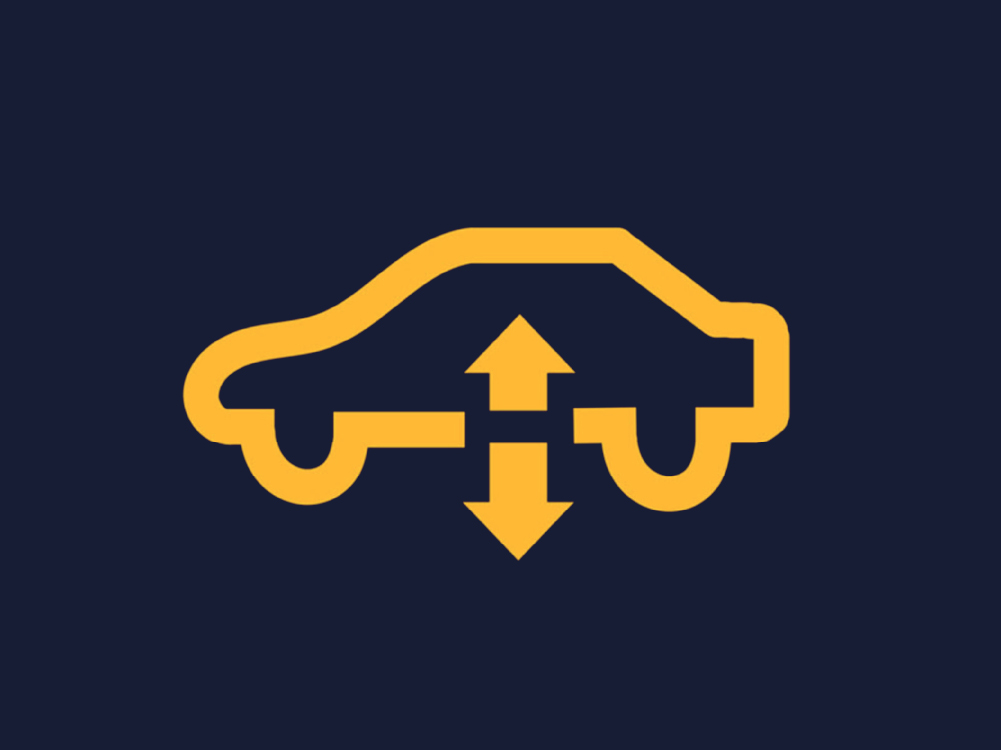
This light indicates that the air suspension system cannot properly absorb bumps and road irregularities. The main causes include:
- Fault in one of the suspension’s valves or sensors
- Leak in the air suspension system
- Worn shock absorbers or springs
- Malfunction in the system’s control unit
You can still drive the vehicle when this light is on, but the suspension performance will be affected, reducing ride comfort and vehicle stability. Therefore, it’s advised to not not drive the car for a long time and have the system inspected to prevent serious damage.
Exhaust Emissions Warning Light (Catalytic Converter)
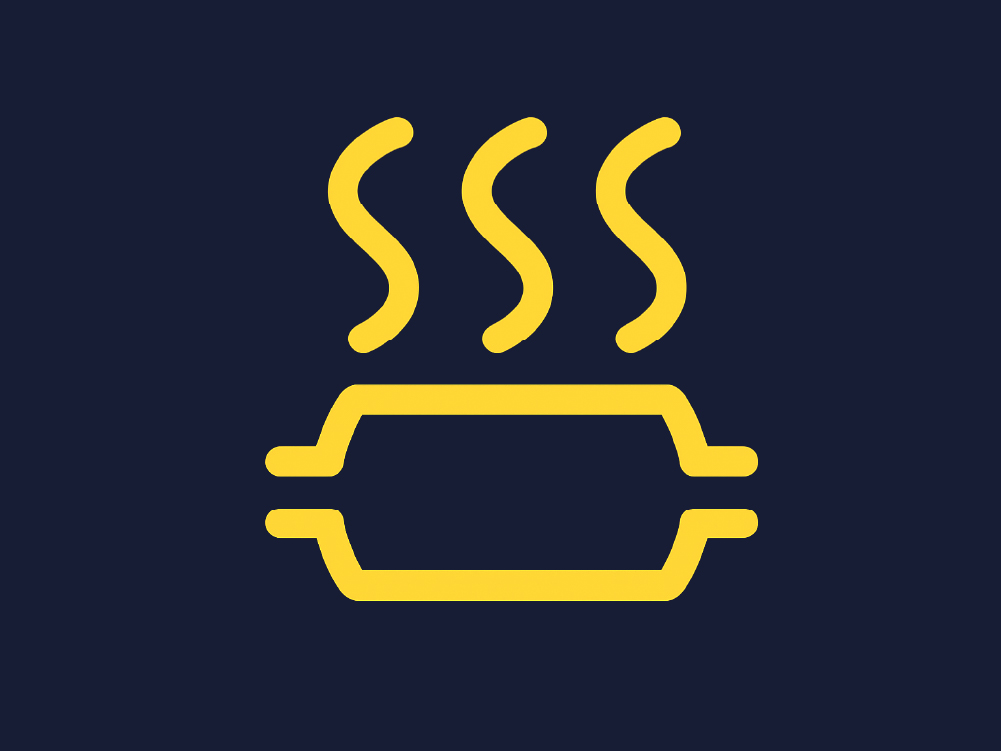
This indicator alerts the driver that there’s an issue with the catalytic converter or the exhaust emissions system. Possible causes include:
- Damaged or clogged catalytic converter
- Fault in the oxygen sensor
- Malfunction in the fuel injection system or spark plugs
- Engine overheating
The driver might notice increased fuel consumption and other related signs when this symbol appears on the dashboard. Therefore, it’s recommended to have the vehicle inspected at a service center to prevent severe damage.
Electronic Stability & Traction Control Warning Light
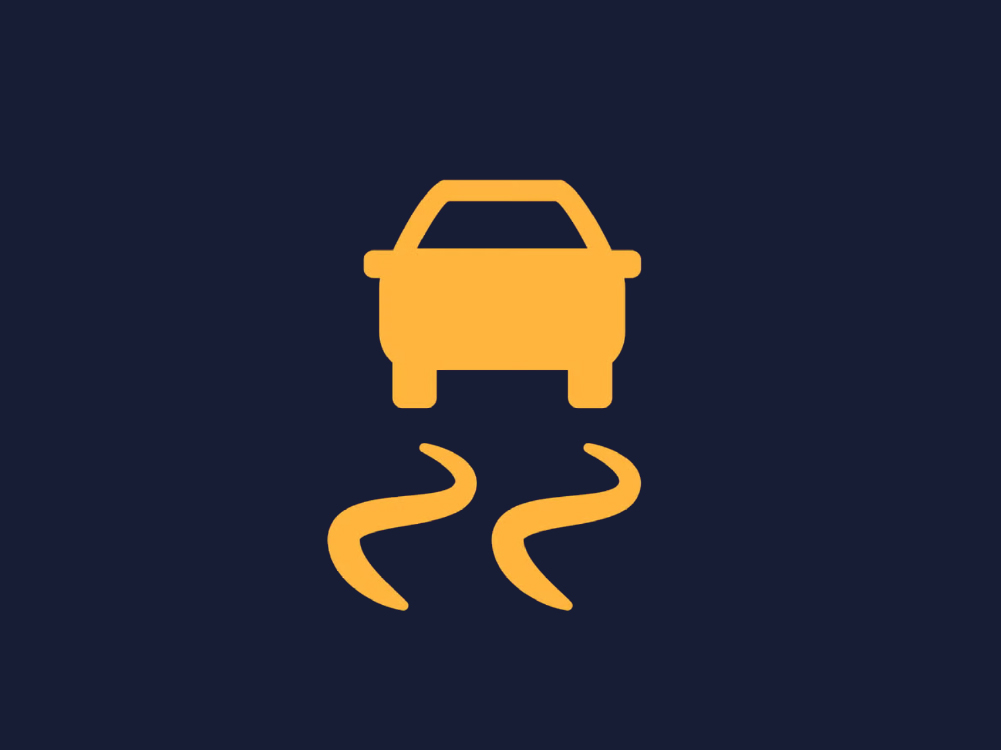
This light informs the driver that the system has been activated while driving, as the sensors detect when the vehicle begins to skid or lose traction with the road. However, if the light remains on continuously, it indicates a problem with the Electronic Stability Control (ESC) or Traction Control System (TCS), which requires inspection at a service center. Common causes include:
- Fault in one of the wheel speed sensors
- Low battery voltage or a battery issue
- Malfunction in the system’s control unit
Sometimes, the driver might need to turn off these systems when driving on sand, mud, or snow, as a bit of wheel slip can actually help the car navigate these surfaces more effectively, in such cases, the dashboard will display the ESC OFF or TCS OFF symbol.
Forward Collision Warning Light with AEB

This indicator warns the driver of a potential frontal collision, as the system’s sensors monitor the distance between your car and obstacles or vehicles in front, so if you are approaching too quickly, the light flashes accompanied by a warning sound, telling the driver to press the brake pedal. This light might appear due to other reasons:
- Fault in the radar sensors
- Dirt or debris on the front cameras
- Challenging road conditions, such as heavy fog or direct sunlight
- Software or electrical issue in the system
In some vehicles, the system may also apply automatic emergency braking (AEB) to avoid collision if the driver didn’t act fast enough.
Make sure to clean the sensors and cameras regularly, and have the system checked if the light stays on. Keep in mind that this system assists the driver but doesn’t replace complete focus and safe driving.
Tire Pressure Warning Light

One of the most important car dash warning lights is the tire pressure, which alerts the driver when the air pressure in one of the tires is low or unbalanced. This light might also appear due to other reasons, such as:
- Normal pressure drop due to cold weather or a minor leak
- Punctured or damaged tire
- Fault in the tire pressure sensor or its battery
Tire pressure should be checked regularly and inflated per the manufacturer’s guidelines. If the light remains on, avoid high speeds to ensure safety and prevent tire damage.
Coolant Temperature Warning Light
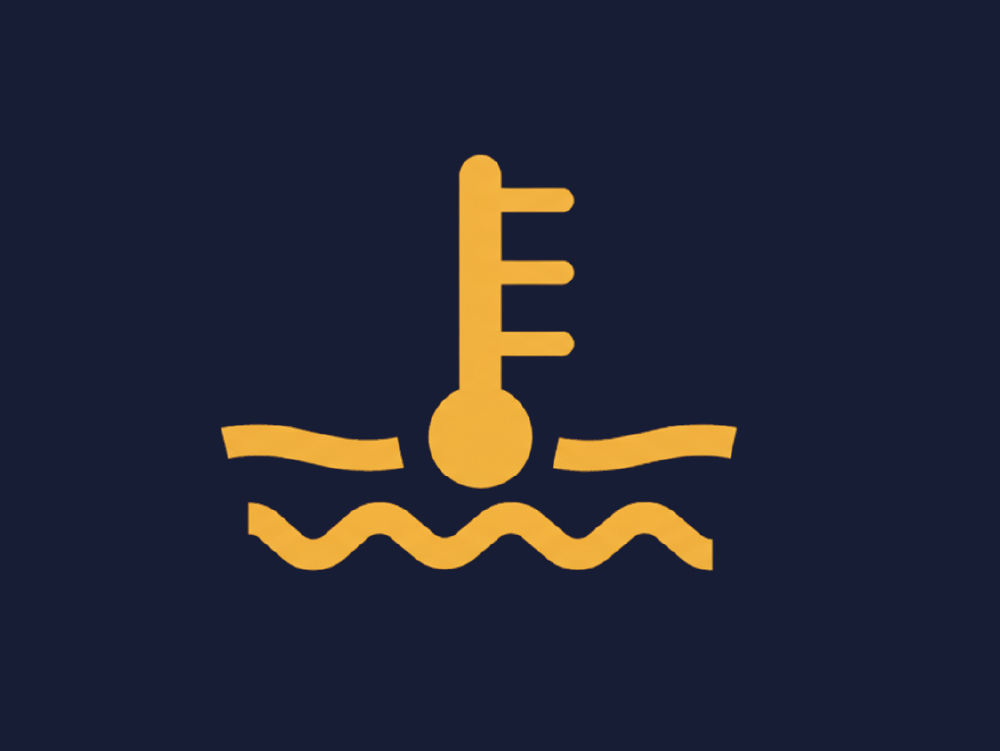
This warning symbol tells the driver that the engine coolant level is low, which can happen naturally due to evaporation or minor leaks. A warning sound might also accompany the light. There are other causes for this warning light:
- Coolant leaks from hoses or the radiator
- Fault in the coolant level sensor
It’s best to check the coolant level regularly and refill it according to the manufacturer’s guide, but, if the light remains on, visit a service center to inspect the system and ensure there are no major leaks or other faults that can affect the engine’s safety.
Airbag Warning Light

This indicator alerts the driver of a problem with the airbags or the seat belts connected to them. Possible causes include:
- Faulty sensors
- Malfunction in the system’s control unit
- Minor electrical issues
- Damaged or disconnected wiring
- Improper replacement of airbags or seats
Make sure to have the vehicle inspected immediately to ensure passenger safety, moreover, avoid attempting to modify the airbags or seat belts by yourself.
Bulb Monitoring Light

When there’s a problem with one of the vehicle’s bulbs or the electrical systems connected to it, this warning appears on the dashboard. Possible causes include:
- Burned-out front or rear bulb
- Damaged wiring or blown fuses
- Fault in the electronic lighting system, such as smart lighting or LED bulbs
While this warning might appear trivial, it’s recommended to visit a service center to inspect the system and diagnose the cause before it affects the entire lighting system or other electrical components.
Yellow Battery Warning Light

The yellow battery warning light sometimes appears to alert the driver of a potential issue with the battery charging system. Possible causes include:
- Temporary drop in battery charge
- Loose battery terminals
- Minor fault in the alternator or its belt
This light doesn’t indicate a serious battery failure but rather a minor issue. It usually turns off after checking the battery and securing the terminals, or after running the vehicle for a short period while the system returns to normal without needing further inspection.
Blind Spot Warning Light
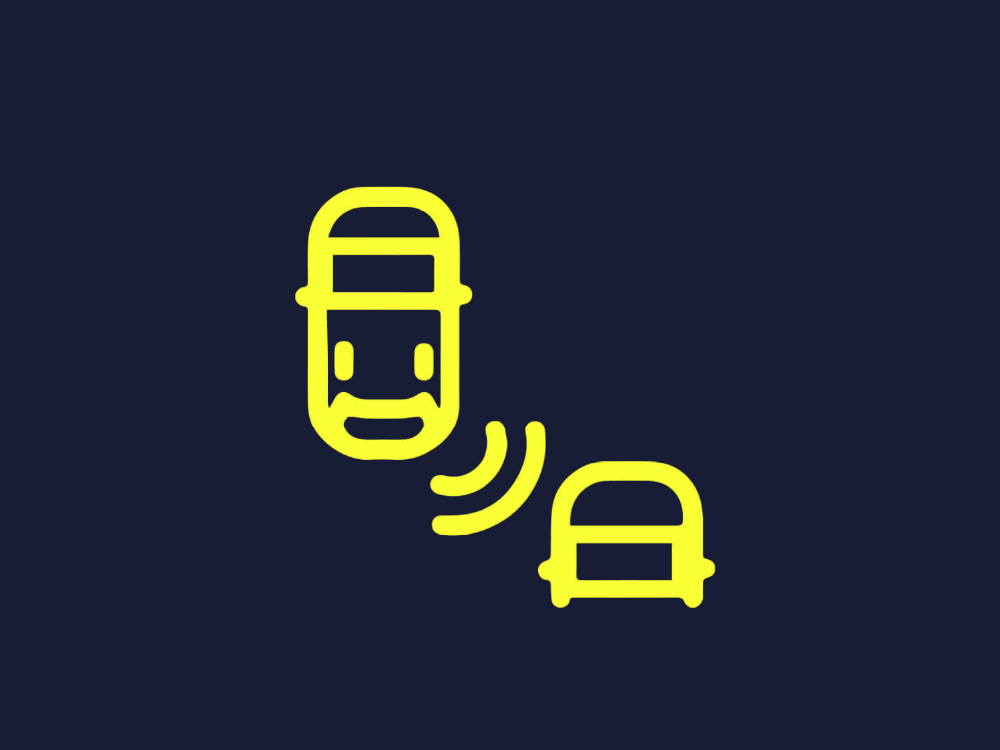
This light tells the driver that there’s a vehicle in the blind spot (the area not visible in the mirrors). The light appears on the side mirrors when other vehicles approaches your car’s blind spot, and it flashes if the driver attempts to change lanes at that moment to avoid a collision.
If the light continues to flash with no vehicle in the blind spot, it may indicate a fault in the system, and it must be checked at a service center.
Lane Departure Warning Light

This dashboard indicator alerts the driver when the vehicle begins to drift out of its lane. This system uses front-facing cameras to monitor the road markings, and it detects that the wheels are drifting out of the lane without using turning signals. The warning is either a visual symbol on the dashboard, an audible sound, or a vibration in the steering wheel.
If the light stays on continuously, then the system is malfunctioning, or the camera is blocked due to dirt buildup or weather conditions such as fog. In this situation, you can clean the camera or have the system checked at a service center.
Glow Plug Warning Light (Diesel)

It’s one of the diesel truck warning lights that alert the driver of an issue with the engine’s preheating system (glow plugs). Reasons for this might include:
- Faulty glow plugs
- Malfunction in the control unit
- Low battery voltage affecting the whole system’s operation
While not a critical fault, this light can cause difficulties when starting the engine, especially in cold weather, therefore, it’s best to have the system checked at a service center to ensure the glow plugs are functioning properly.
Fuel Filter Warning Light (Diesel)

This warning light notifies the driver of a possible issue with the fuel filter or the diesel fuel quality. Common causes are:
- Partial clogging in the fuel filter
- Water or unwanted substances in the fuel
- Fuel pump reduced performance due to debris buildup
Typically, this indicator means that the filter needs to be inspected, cleaned, or even replaced to prevent engine performance issues or the car turning off unexpectedly while driving.
Diesel Exhaust Fluid Warning Light

This light indicates a low level of Diesel Exhaust Fluid (DEF/AdBlue) level or a fault in the emissions control system. Other possible causes can be:
- Faulty injectors or sensors
- Poor-quality fluid
- Contaminated exhaust fluid
This issue isn’t critical enough to prevent the vehicle from operating, but it should be addressed quickly to avoid reduced engine performance or putting the vehicle into “Limp Mode”.
* Limp Mode: a protective feature designed to shield the engine or transmission from severe faultsa
Clogged Air Filter Warning Light (Diesel)

This symbol lights up when there’s a partial blockage or reduced performance of the air filter in a diesel engine. This can stem from:
- Accumulation of dust and dirt on the filter
- Excessive moisture or debris affecting the airflow
- Old or low quality filter
The air filter should be checked as soon as possible to prevent reduced engine performance, increased fuel consumption, and triggering the car to enter Limp Mode.
* Limp Mode: a protective feature designed to shield the engine or transmission from severe faultsa
AWD System Warning Light

This ranks as one of the most important dashboard warning lights, as it warns the driver of a possible issue with the all-wheel drive (AWD) system, which can affect the vehicle’s ability to distribute power to all four wheels, especially on slippery or rough roads. This warning might be triggered by:
- Fault in the AWD control unit
- Low fluid or oil pressure in the transfer case or drivetrain
- AWD sensors malfunction
This warning usually doesn’t prevent you from driving the vehicle, but make sure to avoid challenging road conditions or sharp turns until the issue is resolved at a service center.
Electronic Throttle Control Warning Light
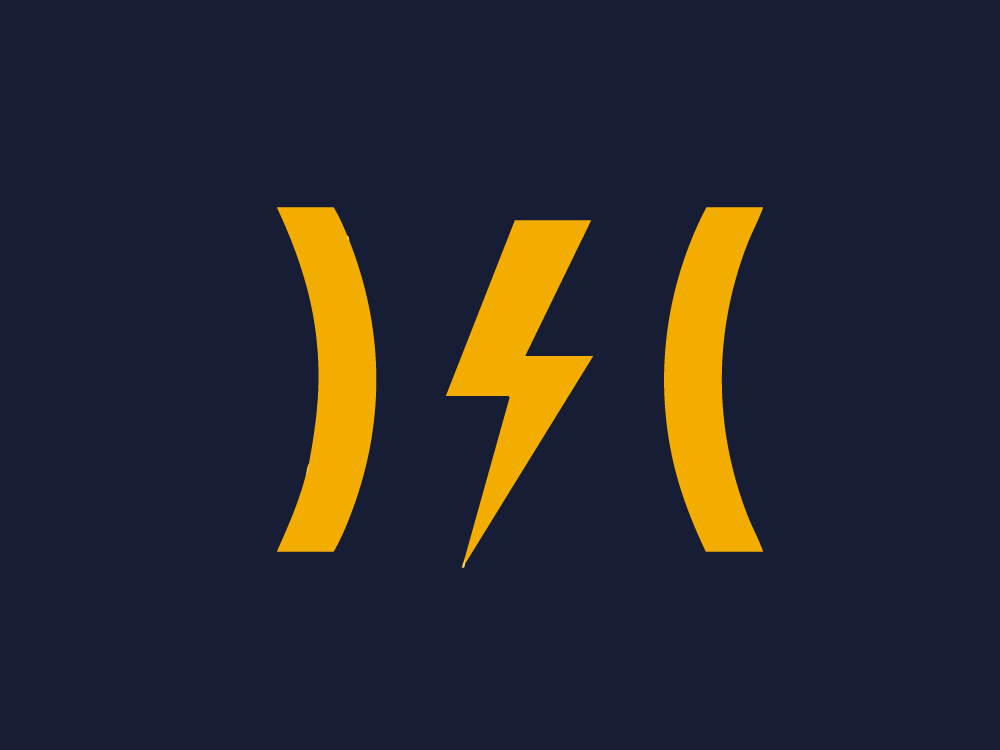
Any issue in the ETC system can cause this light to appear on the dashboard, as this system’s main job is to regulate the amount of air entering the engine, ensuring a smooth performance and a proper response when pressing the accelerator. Possible causes for this light appearing can be:
- Faulty throttle pedal sensor or throttle position sensor
- Damaged wiring or electrical wiring
- Issue with the engine control unit (ECU)
This can cause reduced engine performance or abnormal accelerator response, which is why you must go to a service center to identify and fix the issue before it becomes worse. Also, while this light is still on, make sure to drive cautiously and avoid sudden acceleration.
Green & Blue Dashboard Lights (Standard Functions)
Green Indicators
These indicators appear in green to show that a system in the vehicle is active and working properly:
- (1) Cruise Control
- (2) Eco Mode
- (3) Low Beam
- (4) Auto Lights ON
- (5) Headlights ON
- (6) Auto Hold
- (7) Front Fog Lights ON
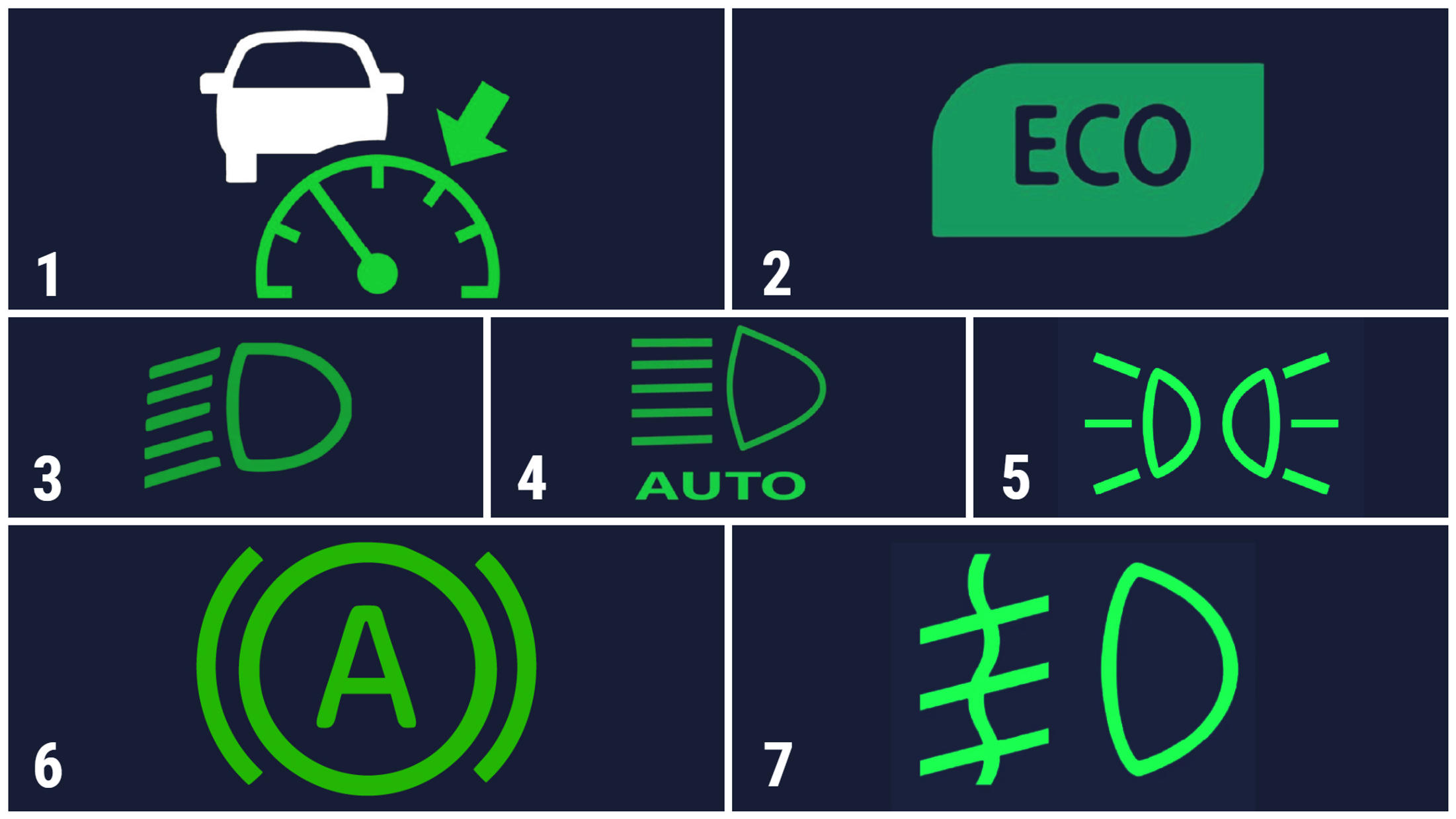
Blue Indicators
Some indicators appear in blue when certain systems are activated:
- (1) High Beam ON
- (2) Cool Engine Indicator: engine is still cold and has not yet reached the optimal operating temperature
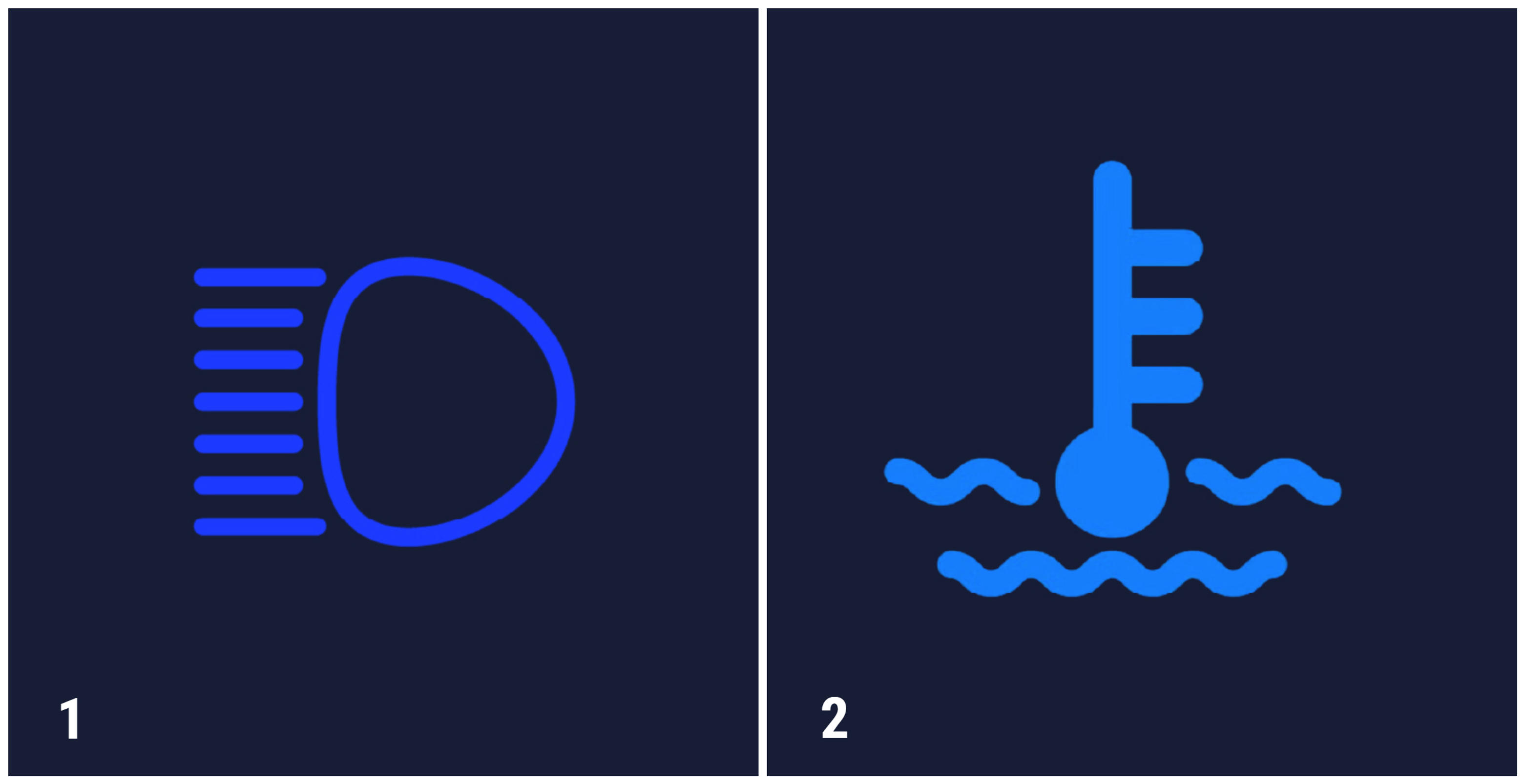
Other Indicators
- (1) Door ajar warning
- (2) Open bonnet (front hood) warning
- (3) Trunk lid open warning
- (4) Loose fuel cap warning
- (5) Low windshield washer fluid warning
- (6) Front windshield defogger is on
- (7) Rear windshield defogger is on
- (8) Front wipers set to automatic mode
- (9) Low fuel warning light
- (10) Smart key is not near the vehicle or not inside the vehicle
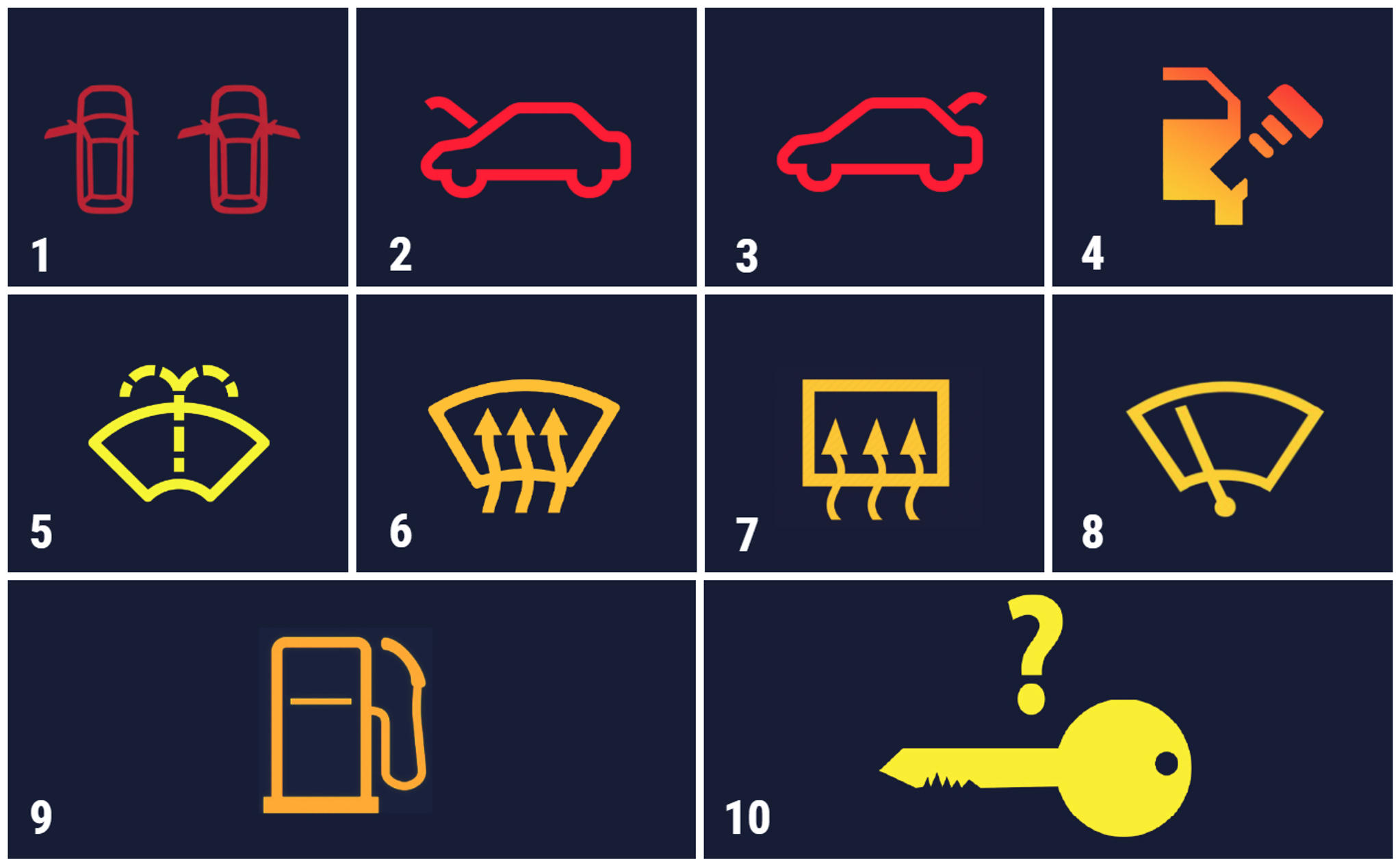
Frequently Asked Questions
What are the three main warning lights?
- Red lights: indicate serious issues requiring immediate attention
- Yellow or orange lights: indicate system faults that should be checked soon but not immediately
- Green or blue lights: indicate normal system operation
How to clear warning lights?
- Fix the issue causing the light to appear
- Switch the engine off then start it again
- Use an OBD scanner (on-board diagnostic) if the light persists
How to read car warning lights?
Check your owner’s manual to look for the symbols’ meanings.
What does oil warning light means?
It means that the engine oil level or pressure is low and needs immediate attention.
What is a panel warning light?
It’s a light or an indicator on the dashboard that alerts the driver to a specific system status or problem in the vehicle.
Can I drive with the tyre pressure warning light on?
Yes, but only for a short distance. It’s best to stop and check the tire pressure as soon as possible to avoid damage or unsafe driving conditions.
In conclusion, we explored the car dash warning lights and their meanings, because understanding them can allow the driver to respond appropriately and protect both the vehicle and its occupants from faults and hazards.
Always make sure to perform regular vehicle inspections at service centers. It’s better to be safe than sorry. And if you’d like to learn more about car parts, engines, and other similar topics, or if you want to stay up to date with the latest automotive news and new releases, you can visit Motory Auto News section.






